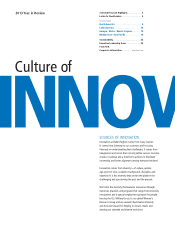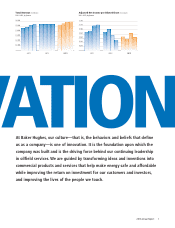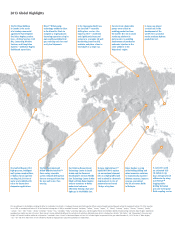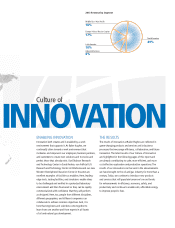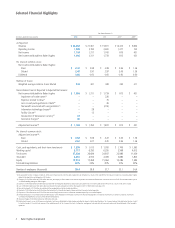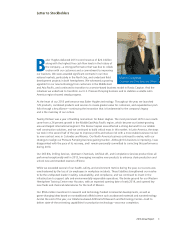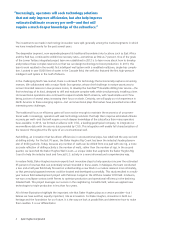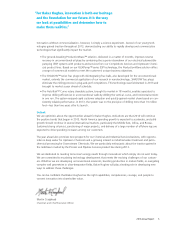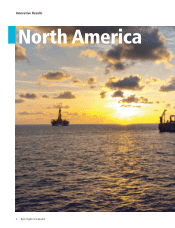Baker Hughes 2013 Annual Report Download - page 9
Download and view the complete annual report
Please find page 9 of the 2013 Baker Hughes annual report below. You can navigate through the pages in the report by either clicking on the pages listed below, or by using the keyword search tool below to find specific information within the annual report.” Increasingly, operators will seek technology solutions
that not only improve effi ciencies, but also help improve
estimated ultimate recovery per well—and that will
require a much deeper knowledge of the subsurface.”
The investments we made in technology innovation were split generally among the market segments in which
we have invested heavily for the past several years.
The deepwater segment, now expanding beyond its traditional boundaries into locations such as East Africa
and the Red Sea, continued to exhibit low recovery rates—sometimes as little as 7 percent. One of the goals
of the Lower Tertiary integrated project team we established in 2012 is to learn more about how to develop
and produce these complex reservoirs so that we can design technology to boost production. In 2013, this
team’s work resulted in the world’s fi rst intelligent well system with a modifi ed multizone, single-trip comple-
tion. Located in over 8,000 feet of water in the Cascade fi eld, the well also featured the fi rst high-pressure
intelligent well system in the Gulf of Mexico.
In the challenging North Sea market, there is a demand for technology that economically captures remaining
reserves. We collaborated with a major North Sea operator, whose chief challenge in mature assets was to
recover stranded reserves in low-pressure zones, to develop the SureTrak™ steerable drilling liner service—the
fi rst technology of its kind, designed to drill and evaluate complex wells while simultaneously installing a liner.
Unconventional operations also continued to expand outside North America, with Saudi Arabia and China
being just two of several areas increasing their focus on shale. Certainly, we will apply our rich experience in
North America to these emerging regions—but unconventional plays themselves have presented some other
interesting new challenges.
The traditional focus on effi ciency gains will soon not be enough to maintain the economics of unconven-
tional wells. Increasingly, operators will seek technology solutions that help them improve estimated ultimate
recovery per well—and that will require a much deeper knowledge of the subsurface than many operators
have available. In 2013, we formed an alliance with CGG, a leading geophysical company, to integrate our
near-wellbore data with the seismic data provided by CGG. This integration will enable full characterization of
the reservoir throughout the life cycle of an unconventional well.
Pad drilling, an innovation that has driven effi ciencies in unconventional plays, has redefi ned the way we look
at drilling activity. For the last 70 years, the Baker Hughes Rig Count has been the industry’s leading barom-
eter of drilling activity. Today, because any number of wells can be drilled from one pad with one rig, a more
accurate refl ection of drilling activity is the number of wells, rather than the number of rigs. In the second
quarter, we launched the Baker Hughes Well Count—a unique index that augments the Baker Hughes Rig
Count to help the industry track and forecast U.S. activity in a more informed and comprehensive way.
In mature fi elds, Baker Hughes reservoir experts took innovative steps to help operators recover the estimated
65 percent of reserves that can potentially remain stranded in these assets. In Malaysia, the team conducted
a two and a half-year fi eld study focused on understanding a new block in a mature reservoir more intimately,
so that previously bypassed reserves could be located and developed successfully. This study resulted in a multi-
year mature fi eld redevelopment project with Petronas Carigali in the offshore Greater D18 fi eld. In Mexico,
we won a multiyear contract with Pemex to optimize production and operational effi ciency in the declining
Soledad fi eld. This project leverages our success in the neighboring Corralillo fi eld, where we applied new
technologies to triple production in less than four years.
All of these illustrations highlight the important role that Baker Hughes plays as a service provider—but I
believe we have another, equally important, role as innovators. For Baker Hughes, innovation is both our
heritage and the foundation for our future. It is the way we look at possibilities and determine how to make
them realities. It is our differentiator.
4 Baker Hughes Incorporated



